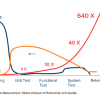Design & Develop
Articles
 |
7 Simple Tips for Better Performance Engineering Rigorous practices to reinforce performance and resilience, and testing continuously for these aspects, are great ways to catch a problem before it starts. And as with many aspects of testing, the quality of the performance practice is much more important than the quantity of tests being executed. Here are seven simple tips to drive an efficient performance and resilience engineering practice. |
|
 |
5 Key Factors to Achieve Agile Testing in DevOps Part of the path to DevOps requires adoption of agile methodologies. What does it mean for testing when you switch from the traditional waterfall model, with a few long release cycles per year, to the agile model, with changes occurring every two weeks? Here are five key factors to achieve the agile software testing necessary in DevOps. |
|
 |
The Shift-Left Approach to Software Testing The earlier you find out about problems in your code, the less impact they have and the less it costs to remediate them. Therefore, it's helpful to move testing activities earlier in the software development lifecycle—shifting it left in the process timeline. This article explores the shift-left methodology and how you can approach shifting left in your organization. |
|
 |
Why You Need Continuous Testing in DevOps DevOps is more than adopting the right set of tools; it's a cultural shift that incorporates testing at each stage of the agile project lifecycle. Continuous testing is key to unlocking this culture change because it weaves testing activities into every part of the software design, development, and deployment processes, which helps everyone involved communicate more, collaborate better, and innovate faster. |
|
 |
When DevOps Gets Lost in Translation The waterfall method of developing software is a bunch of translation activities: The design is a translation of the requirements into the language of architecture, the code is another, and a formal test process is a third. And with each translation, there’s the opportunity to introduce error. When your DevOps team is isolated, it creates another handoff, and another point of failure. |
|
 |
7 Ways Monitoring Can Help You Be a Better Tester Monitoring makes your testing work easier, helps you manage certain biases you may have, and lets you learn a lot about the product, users, and even your own processes. Here are seven concrete benefits testers get from monitored data that you can use to convince your team to implement monitoring—as well as realize for yourself. |
|
 |
Shifting Testing Left Bakes In Quality from the Start “Shift left” is one of the latest buzz terms in software testing. Movements like agile and DevOps recommend that testers shift left, but what does that mean, exactly? Here's how one tester became a believer in the shift-left movement; how he got his team's developers, analysts, designers, and managers on board; and how his entire organization has benefited from the shift. |
|
 |
5 Ways to Optimize Tests for Continuous Integration Many teams have existing automated test suites that are not included in a continuous integration program. Maybe the tests take too long to execute, or they are not reliable enough to give accurate results. Here’s how to assess your test suites in terms of value added and time to execute, along with five proven strategies to optimize those suites for CI. |
|
 |
Measuring the Performance of Your Operations Center Many organizations have problems with consistently tracking and measuring system outages. Issues aren't logged, admins make changes to systems without going through change management, and a high number of issues turn out to be recurring problems. Implementing a performance measurement process calculates system reliability and can help you improve consistency. |
|
 |
Shifting Testing Left Is a Team Effort There is a lot of talk in the testing world about shifting left. Basically, “shift left” refers to moving the test process to an earlier point in the development process, independent of the development approach. This article explores a case in which shift-left has been applied, and the lesson is that shifting left cannot be achieved by testers alone—it must result from a team effort. |












